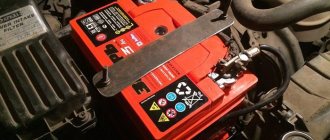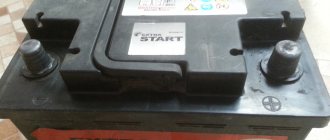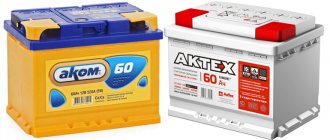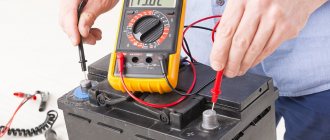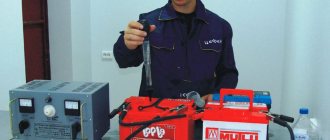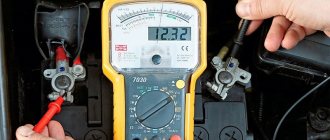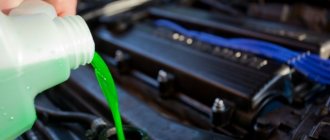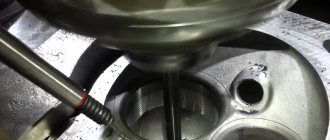Many drivers, leaving the car for a while, then discover that it does not want to start. At this time, the starter may not show any signs of life at all. Most likely the reason is the battery, which has been discharged in a few days. Charging in such a situation does not always help. The root of the problem is a decrease in electrolyte density. A car service center will help you return it to normal, but many people prefer to act on their own. How to increase the electrolyte density in a battery with your own hands and why its level changes is in the article. In general, this is a common occurrence, and a battery that lasts 3–5 years is considered a consumable item.
Equalizing the density of the electrolyte will help extend the life of the battery.
What is the density of electrolyte in a battery?
A lead-acid battery contains containers called "cells". They contain sulfuric acid, into which lead plates are immersed. If the electrolyte boils away, its chemical composition changes, or sulfation occurs (damage to the plates), the battery may fail. In non-critical situations, there are ways to restore the power source at home.
The electrolyte itself is a liquid that serves as a catalyst for the electrochemical process. Without it, a battery is nothing more than plastic filled with lead. The electrolyte consists of approximately 65% distilled water and 35% sulfuric acid. One of the indicators of this “chemistry” is density, which can either fall or rise, depending on the charge of the battery.
How to adjust the density of the solution?
The optimal value should be in the range of 1.25–1.29 g/cm3, under normal climatic conditions, ambient temperature +25 degrees.
If a lower result is found, then the indicator needs to be increased. Sometimes it turns out that the result of only one of the cells is significantly lower than the norm. This indicates a defect - a short circuit that has occurred between the plates. Exceeding the norm suggests that the electrolyte was boiling.
If you want to increase the density of your car battery at home, you need to be careful. The process is simple - you will need a container into which you can drain the old liquid from the storage tank, a syringe, and a measuring cup. For recovery, it is better to use a ready-made electrolyte. If you want to make a solution yourself, take into account the rule - acid is added to the water, otherwise the composition will boil.
Main stages:
- The battery and protection are removed, and the lids of the cans are unscrewed.
- Next, using a syringe, you need to remove as much liquid as possible from all the jars one by one. At this point it is important to measure the amount of solution.
- To restore the proper level, add a corrective composition in the appropriate volume. The reservoir is rocked a little, so the liquid is stirred a little.
- Next, the battery is sent for recharging. This will allow the mixture to mix completely. After all, the device cannot be shaken strongly or completely turned over - this leads to shedding of the plates.
- After 30 minutes, the battery is turned off, control is carried out after 2 hours, so that there are no errors.
- If the required level is not restored, the procedure is repeated again.
Important:
The error between the results obtained is allowed no more than 0.01 g/cm3.
Maintaining optimal electrolyte density is extremely important for the performance of the drive; the capacity of the car battery also depends on it. An increase in density leads to an increase in the capacity of the positive electrodes, while the capacity of the negative electrodes decreases, especially when the temperature drops.
Also, a decrease in the temperature of the electrolyte can cause a reduction in the discharge capacity due to an increase in viscosity.
What factors affect density
Before figuring out how to increase the density in a battery, it is necessary to identify why it may fall. The reasons are as follows:
- discharge. Less charge means lower density of sulfuric acid. During charging, the parameter gradually increases. When a battery has been in use for a long time, part of its energy capacity is lost, which is accompanied by a drop in electrolyte concentration;
- the battery life is coming to an end, or storage rules have been violated (if you leave the car in cold conditions for the winter, this will damage the battery);
- Some of the electrolyte has boiled away due to overcharging. When the charger provides increased voltage, the liquid turns into a gas and is removed through the vents on the battery case;
- The car owner often adds water to maintain the electrolyte level. When doing this, you need to get a device for measuring density, since the acid boils away along with the water. The result is low concentration.
The density value determines how efficiently the power supply will hold a charge. For this reason, it is recommended to periodically measure the parameter, which will help identify the problem in time. If ignored, the lead plates will deteriorate prematurely.
When the density indicator is low, the car simply will not start. In such cases, it is necessary to increase it, thereby restoring the functionality of the battery.
Electrolyte density value for battery.
Why is density decreasing?
The density of the electrolyte changes during battery use. When the battery loses charge, the indicator decreases, and vice versa. Very low electrolyte density is due to the following reasons:
- The influence of low temperatures for a long time;
- The battery is overcharged, resulting in the electrolyte boiling away;
- Regular addition of water.
You can add water to the electrolyte, but before doing this you need to check its density and not carry out the procedure unless necessary. Take measurements in each jar. Normal values are from 1.25 to 1.29. The colder the region, the higher the density should be.
Why are low and high electrolyte concentrations dangerous?
Due to the increased concentration, the battery will fail faster. Acid is destructive to metal plates - “chemistry” can even ruin steel.
Low concentration leads to:
Sulfation of the battery plate.
- sulfation. This is the name of the process when a whitish coating appears on lead plates - lead sulfate deposits. With them, the battery takes a charge worse, or even refuses to charge at all;
- increasing the freezing threshold. When the density is 1.28 g/cm3, the liquid freezes only at a temperature of -58°. If it is lower, it will freeze even at -5°. Ice damages the plates, increasing the risk of a short circuit, after which it is no longer possible to “reanimate” the battery;
- problems with starting the engine, especially in winter.
Preparing to restore the battery
At the preparation stage, perform the following actions:
- This basic indicator of a car battery is measured at a temperature of about 22 degrees. This can be done using a special device - a hydrometer. In this case, you can only work with gloves and safety glasses to avoid possible burns.
- When preparing a new electrolyte, acid is added to water. If you do the opposite, the liquid will begin to boil , which can lead to acid burns.
- It is strictly forbidden to turn the battery over when working with it, as this may cause its plates to fall off, which will lead to failure of the device.
- You should prepare containers in advance into which the old liquid will be drained and the new liquid will be prepared.
- Accurate calculations of the required volume of acid will be required, since during the charging process the density of the liquid in the battery will increase.
How to check electrolyte density
The procedure is simple, you can do it yourself. It is recommended to carry it out at room temperature. Before you begin, prepare the following:
- personal protective equipment (gloves, goggles). If electrolyte gets on exposed skin, it can cause a burn. Chemical vapors are also dangerous, so work is carried out in a well-ventilated area;
- densimeter. This is the name of a device for measuring density. It looks like a glass tube with a bulb that has a built-in hydrometer.
How to measure density correctly:
- Remove the power source from under the hood, remove the protective cover, if there is one, and unscrew the plugs.
- First, the electrolyte level is assessed. In the case of lead-acid batteries, it should cover the plates by 1.5 cm.
- Fully charge the battery. After charging, allow it to “rest” for 5–6 hours, and then measure the density. If the level is normal, immerse the device in jars and pump out some liquid. The hydrometer should float freely without touching the walls.
- They look at the indicators and compare them with normal values (the norm depends on the region, since climatic conditions are different everywhere).
In this way, you can only check the battery being serviced. If the battery is maintenance-free, there is an indicator, the color of which indicates the level of electrolyte density.
Electrolyte density indicator.
Preparing the Battery
When a car enthusiast knows why the density of the electrolyte in the battery has dropped, then there is no need to immediately raise it. It is necessary to carry out some preparatory activities. To do this, you must ensure that several conditions are met:
- The battery is charged.
- The temperature of the solution in the batteries is from 20 to 25 degrees.
- The electrolyte level in each jar is normal.
- The battery has no mechanical damage.
We recommend: Composition of electrolyte for acid car batteries
If the battery is discharged, its capacity should first be restored. Then the density of the solution must be measured, since the acid concentration may be below normal. A situation is possible in which this solution parameter after recharging in batteries is different. It should be remembered that the permissible difference in this indicator is a maximum of 0.01 kg/cm3. To equalize the density values in the banks, it is necessary to carry out corrective recharging. This is done as follows:
- The current strength is reduced by 2-3 times compared to the nominal value.
- The battery charges within 1-2 hours.
If this method does not help solve the problem, you will have to take a more serious measure by adding a correction electrolyte solution. It should be noted here that it can only be used as a last resort.
An electrolyte whose density is 1.4 kg/cm3 is called a correcting electrolyte.
First, the car owner should check the battery and find out why the concentration of the solution disappears. If this happened due to boiling water, then the correction electrolyte cannot be added. It is used only in two cases:
- A liquid leak has been detected from the batteries.
- A lot of distilled water was poured into the jars, which caused a decrease in the density of the solution.
Enhancement Methods
For the engine to start properly, the power source must be charged, and experienced drivers ensure this. But situations are different. There are several ways to increase density, which vary in complexity.
Correction electrolyte
Increasing the density in this way is carried out in stages, and in order to achieve the desired result, consistency is required.
Before starting work, you should prepare: a hydrometer, glass containers, a bulb, protective equipment, water and correction electrolyte. The battery must be warmed up - just leave it in a warm room for several hours.
Procedure:
- The power supply is fully charged, which takes at least 8 hours.
- Chemical indicators are measured. It should be from 1.25 to 1.27 g/cm3.
- If it is lower, the electrolyte is partially drained from the cans.
- Next, you need to add a correction electrolyte to them (half as much as was pumped out).
- Add water to cover the lead plates.
- The battery is charged for 30-60 minutes, and then they wait a couple of hours for the liquid to mix.
- The indicators are measured again.
If the density does not rise, repeat the steps.
Many people do not buy, but make the corrective electrolyte themselves. In this case, you must first add water, and only then the acid solution.
Preparation of electrolyte from water and acid.
Alignment
This method is suitable if the plates are free of defects or have slight plaque. Before proceeding, charge the battery with a low current. After 12 hours, charge again, setting the voltage to 14.6 - 14.8 V.
The method is often used in winter, when the electrolyte concentration drops. They restore with weak currents, but charging can take up to three days.
How it works: the acid solution begins to “boil”, which is accompanied by bubbles on the surface, and when the excess liquid evaporates, the concentration of the electrolyte increases. Since it will eventually become less, you will have to add a new solution, and only then measure the density and look at the hydrometer readings.
The method, although long, is effective, especially when there is no other way to restore the battery.
Replacement
If the density of the acid solution drops below 1 g/cm3, there is no point in raising it. The solution is a complete replacement of “chemistry”.
Instructions:
What is needed to replace the electrolyte in a battery?
- To begin with, the electrolyte is completely pumped out of the “cans” using a bulb.
- Carefully turn the battery over, place it on its side, and drill holes in each “can.” The remains are drained from them.
- All “jars” are washed with distillate, and the holes are sealed with acid-resistant plastic.
- Fill in a new electrolyte of the required density.
- Charge the battery and check how it works.
When working with the battery, you need to be careful, especially when turning it over. The fact is that at the bottom of the “cans” there remains a lead residue, and if you turn it over sharply, it will get stuck between the plates and short-circuit them. It will no longer be possible to “reanimate” such a battery.
These are extreme measures, and only enthusiasts resort to them, since a mistake can damage not only the power source, but also the car.
Although a rechargeable battery is considered a consumable item, it can last longer if properly cared for. Checking and adjusting the density and level of electrolyte is one of the points. You can handle all the work yourself, but if you don’t have enough experience or time, no one has canceled the service station.
How to boost using a charger
Another way to restore battery performance is to recharge it at a low current. This method requires a lot of time, but is quite effective if the electrolyte density does not rise to normal levels. The essence of the method is that the battery can be charged to full capacity independently, through a charger. When the charge is maximum, the liquid will begin to boil. A sign of full recharging will be the appearance of small bubbles (distilled water in the battery evaporates). Excess water will evaporate, leaving the acid behind. At the same time, the overall electrolyte level will decrease. Now you can add a new one to the required density. After this, you should measure the readings with a hydrometer and if they are insufficient, then repeat the entire procedure until a standard of at least 1.25 g/cm3 is reached.
If the question arises about buying a new or restoring an existing battery, then of course it is cheaper to choose the second, especially since the work is not difficult and after reading the article carefully, even a person who is poorly versed in technology can easily do the work of increasing the density of the electrolyte and restoring battery performance for at least a couple of seasons. This is a serious budget saving, especially since a high-quality battery costs a lot of money.
Battery selection
The battery life is usually from 3 to 5 years. When choosing, you should consider the following features of cars and batteries:
- You should buy a battery with a capacity that matches the type of car you are using. This is usually indicated in the technical description of the car. Most often this value is in the range of 45-65 ampere-hours.
- There are two types of batteries: serviced and maintenance-free. The serviceable ones are easier to charge and the electrolyte in them can be restored by topping up.
- For off-road driving and bad roads, it is better to take a battery with protection from vibrations and shocks. For short trips, it is better to buy a maintenance-free battery; it is recharged faster from the generator.
